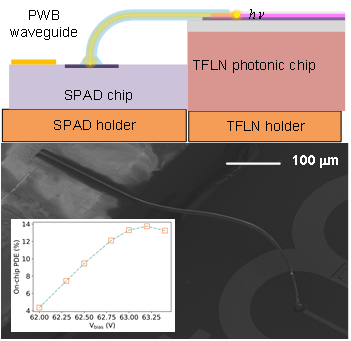 返回
返回Ph.D. candidate Xiaosong Ren’s work about the integration of thin-film lithium niobate photonics chip and single-photon avalanche diode chip via photonic wire bonding was published on Laser & Photonics Reviews.
Thin-film lithium niobate (TFLN) has been an important platform for integrated quantum photonic chips due to its excellent performance on high-speed electro-optic modulation, low-loss waveguides, and strong nonlinear effects. However, the realization of compact, stable, and relatively cost-effective single-photon detection on TFLN photonic chips remains challenging. Photonic wire bonding (PWB) is a flexible chip-to-chip and chip-to-fiber optical interconnection technology. We collaborate with teams from the Department of Precision Instrument of Tsinghua University, Beijing Academy of Quantum Information Sciences, and Yunnan University to integrate InGaAs/InP single-photon avalanche diodes (SPADs) and TFLN photonic chips using PWB technology. A polymer waveguides with a suspended span of over 300 μm is fabricated through two-photon polymerization to connect the TFLN chip and the photon-sensitive area of the SPAD chip, achieving efficient coupling of photons from the TFLN chip to the SPAD chip. The on-chip photon detection efficiency of the integrated SPAD reaches 13.8%, which is the highest level reported for integrated III-V SPADs, more than doubling the previous work. This research provides a robust and convenient solution for integrating single-photon detector chips on photonic chips and has potential applications in quantum communication, on-chip quantum information processing, and weak light sensing.
This work was published at August 18, 2025, on Laser & Photonics Reviews with the title of "Integration of InGaAs/InP Single Photon Avalanche Diode and Thin Film Lithium Niobate Photonic Chip via Photonic Wire Bonding" (https://onlinelibrary.wiley.com/doi/10.1002/lpor.202500826). Ph.D. candidate Xiaosong Ren is the co-first author of the paper, and Prof. Wei Zhang is the corresponding author of the paper.


